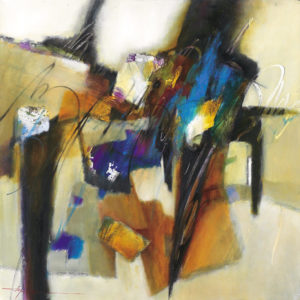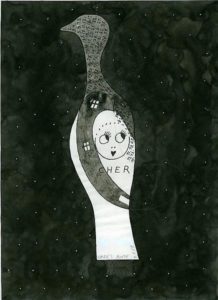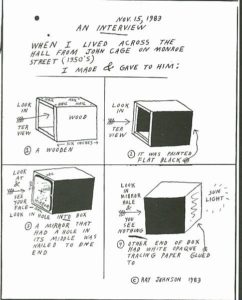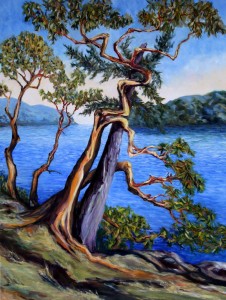Dear Artist,
In 1962, Neo-Dada collagist Ray Johnson, along with some of his Fluxus friends, started sending small works of art to other artists through the United States Postal Service. Dubbed the “New York Correspondence School,” Johnson included instructions to “please add to the artwork” and return it, or send it along to someone else. This creative system, called exquisite corpse, follows the principles of collective assemblage, whereby multiple artists add to a work of writing, collage, drawing or painting in sequence, either by following a rule or instruction, or by only being able to see the last item added by the previous person. Said to have been invented by André Breton as a parlour game in 1925, exquisite corpse started out as a playful, stream of consciousness pastime for Paris’ 1920’s Surrealists but endures today as an enriching creative exercise.
Ray Johnson began sending his mail art to circumvent the insular gatekeeping of the New York gallery scene. He wanted to encourage participation amongst as many artists as possible and disseminate the auteurship of the works created. Always on the fringes but wildly popular amongst its practitioners, mail art continues to populate mailboxes globally. In fact, during lockdown, new mail art projects have sprung up all over, with calls to artists and templates you can print out and add to, and even re-issues of Ray’s original drawings and invitations available on social media. Books, exhibitions, catalogues and libraries of the stuff are even popping up in swanky art spots.
Perhaps the most wonderful thing about mail art is that anyone can participate. You have to embrace the collaborative, never-ending-destination zen of it, and keep a sense of humour. I once met a mail art master at a small vernissage, which spilled into a sidewinding street behind Montmartre. By the time I’d returned to New York, a logroll of portraits, booklets, photocopied zines, postcards and a persistent instruction to send them all back with my additions, sat patiently, secured with a rubber band by the mail carrier, at my doorstep.
Sincerely,
Sara
PS: “The most radical aspect of the New York Correspondence School is the attempted overturning of the American art market through free distribution of art. Johnson’s mail-away art can’t be bought or sold but only received—whether the recipient wants it or not.” (David Bourdon for Art International, 1969)
Esoterica: Screen-free connection is there for the cultivating, just as long as you can get it through the postal system. Envelope-sized works seem to be the standard. “It’s compact. It’s social and also socially distanced from its audience. That makes it exceptionally relevant today,” wrote artist and gallerist Jason Pickleman. Since 2018, Pickleman has issued an open call for mail art and held an annual exhibition in his Chicago gallery, Lawrence & Clark, with the gallery’s mailman jurying a “best in show” and awarding the winner a book of Forever Stamps. And this week, Brooklyn-based artist Christina Massey, in an effort to try to offset threats of cuts to the post office, has issued a call to action on Instagram. So far, Massey has shared over 600 pieces of collaborative mail art on her page. Once a way of circumnavigating the clubby nature of the gallery system, the galleries are now joining in. The Pelham Art Centre in upstate New York, the Ely Center for Contemporary Art in New Haven, Sunset Art Studios in Dallas and Art Gym Denver will show Massey’s collection, which she’s still adding to, this Fall. “Just by the act of doing it,” said Massey, “you are participating in art activism.”
Have you considered a Premium Artist Listing? With each letter, an artist is featured at the bottom of this page. The Premium Artist Listings are a means of connecting artist subscribers through their work. Proceeds from each listing contribute to the production of The Painter’s Keys.
“Anybody can be a mail artist and become part of that network. Even if you don’t feel like a mail artist, you are a mail artist.” (Johanna Rietveld, a manager at the non-profit artist organization, Printed Matter, which is dedicated to the dissemination and appreciation of artists’ books.)
Featured Workshop
 Powerful Design, Sensual Edges put Together with Exciting Color
Powerful Design, Sensual Edges put Together with Exciting Color
Design is the foundation of any painting and you want your paintings to have powerful designs filled with exciting color. In this course we will discover designs two hidden meanings around where you put your center of interest plus how to use neutrals to make your paintings glow and finally add sensual edges that are the soul of the painting.
This workshop will be a live virtual event. I will be there with you during the entire four days. I can’t wait as I am excited. Please email me if you have any questions….gwen@gwenfox.com
August 31 – September 3, 2020, Location…Online
Register here: https://gwenfox.com/retreat/powerful-design-sensual-edges-put-together-with-exciting-color/
Featured Artist
I am a landscape painter exposing the mystery in an ordinary day.









8 Comments
I think Victor Hugo might have been one of the first mail art senders, in the 19th century.
“…Johnson’s mail art can’t be bought or sold…” Utter nonsense. Ray wanted and yearned for financial rewards as most artists do to continue. Was he exasperating to most dealers he dealt with, you bet. Worse than most, yup.
Part of his suicide explanation in his manifesto, he mailed out before his walk into the ocean, was his exasperation of not be “famous” enough and deserving more attention and accolades. You get what you give?
Mail art is huge among calligraphers. The Washington Calligraphers Guild and the National Postal Museum have sponsored a contest every year since the mid-80s, with a theme and prizes. All that is required is a legible address hand lettered of course. Participants choose stamps to match the theme, and the results are amazing.. The images do get displayed, but the joy is in seeing them all online these days. The 2019 winners are shown on this website: https://www.calligraphersguild.org/envwinners2019.html. The 2020 contest has been postponed until 2021 because of the pandemic. Envelopes include both mighty fine lettering and illustration. Be inspired and enjoy.
Thanks Annie for supplying the link on behalf of fellow calligraphers out there. One thing I’ve noticed during this pandemic is that I’m sending, as well as receiving, much more mail art!
Your book is still one of my favourite resources by the way. Many techniques can be practiced on an envelope in one way or another, that my non-calligraphic friends are delighted to receive.
Best to you during these interesting times!
Lois from Ontario, Canada
Thank you for this timely article on :mail art. Both my husband (ramcell) and I (franckeart) were part of this mail art generation in the late 70s throught 1990s. It was a marbelous time to share our art with others. Everyday it was an adventure to go to the mail box in rural NC to see what might be in it and from whence it came.
Thank you so much for sharing! I’ll share away on social too!
We just did an Exquisite Corpse exhibit in Ventura CA as a way for more than 30 artists to “collaborate” during the pandemic. We each did a figure on 4 small canvas boards, and the gallery reshuffled them to make the collaborations. See more at https://www.vitaartcenter.com/exquisite-corpse. I’m pleased that all four figures containing my work have been sold.
Glad I now know what a “vernissage” is, after I Googled it. I’m a Ray Johnson fan, especially in this sad era of “everything-online”.
Pingback: part two; modulating / intervening the social space – e m m a'⠀s ⠀ s t u d i o